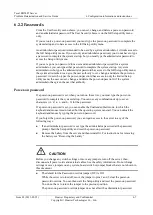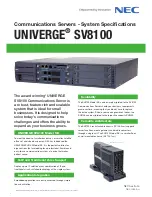
Tecal RH5485 Server
Problem Determination and Service Guide
7 Regulatory Compliance Standards
Issue 02 (2011-05-25)
Huawei Proprietary and Confidential
Copyright © Huawei Technologies Co., Ltd.
7-1
7
Regulatory Compliance Standards
7.1 FCC Certification
The device has been tested and found to comply with the limits for a Class A digital device,
pursuant to Part 15 of the Federal Communications Commission (FCC) regulations.
These limits are designed to provide reasonable protection against harmful interference when
the device is operated in a commercial environment. This device generates, uses, and radiates
radio frequency energy. If it is not installed and used in accordance with the instructions, it
may cause harmful interference to radio communications.
Operation of this device in a residential area is likely to cause harmful interference in which
case the user will be requested to correct the interference by taking protective measures.
If you make any change to this device, which is explictly prohibited by FCC regulations, your
right to operate the device shall be voided.
7.2 CE Certification
European Union Notice: Products that bear the CE lables comply with the EMC Directive
(89/336/EEC) and the Low Voltage Directive (73/23/EEC) issued by the Commission of the
European Union.
If this product has telecommunication functionality, the R&TTE Directive (1999/5/EC) that
complies with these directives implies conformity to the following European norms (in
parentheses are the equivalent international standards and regulations):
EN 55022 (CISPR 22)-Electromagnetic Interference
EN 55024 (IEC61000-4-2, 3, 4, 5, 6, 8, 11)-Electromagnetic Immunity
EN 60950 (IEC 60950)-Product Safety
7.3 UL Certification
Underwriters Laboratories Inc (UL) is a non-profitable product safety test and certification
institute.
UL has its own certification system for the whole product, components, and materials. All the
electric products that are exported to the USA must pass the UL certification.




































